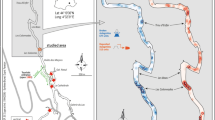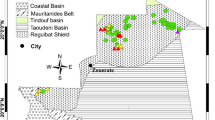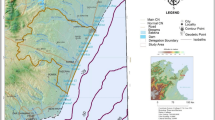Abstract
The karst development of Jiao Dong Peninsula in Shandong Province has formed a unique karst landform, and has become one of the typical karst areas in the north of China. Karst collapse occurred during the construction of high-speed railways and caused many environmental problems. To reveal the development situation of karst area in Shandong, the conventional surface geophysical techniques were used for karst exploration and location of key area. And the results of drilling verification were in good agreement with the results of geophysical exploration. At the same time, the new technology in the field of surveying and mapping 3D laser scanning technology, is cited in the engineering geophysical exploration, and the key issue is the shape and size of the karst. It makes up for the shortcomings of traditional geophysical exploration technology that can only be qualitative and cannot be quantitatively analyzed. It realizes the transformation of karst exploration from regional detection to single cave exploration, and better implements the concept of information construction. It has contributed to the smooth progress of the project and environmental protection.










Similar content being viewed by others
References
Al-Fares W, Bakalowicz M, Guérin R, Dukhan M (2004) Analysis of the karst aquifer structure of the Lamalou area (Hérault, France) with ground penetrating radar. J Appl Geophys 51(2):97–106
Ardestani VE (2013) Detecting, delineating and modeling the connected solution cavities in a dam site via microgravity data. Acta Geod Et Geophys 48(2):123–138
Carbonel D, Rodríguez V, Gutiérrez F, McCalpin JP (2014) Evaluation of trenching, ground penetrating radar (GPR) and electrical resistivity tomography (ERT) for sinkhole characterization. Earth Surf Proc Land 39(2):214–227
Catapano I, Affinito A, Del Moro A, Alli G, Soldovieri F (2015) Forward-looking ground-penetrating radar via a linear inverse scattering approach. IEEE Trans Geosci Remote 53(10):5624–5633
Chalikakis K, Plagnes V, Guerin R, Valois R, Bosch FP (2011) Contribution of geophysical methods to karst-system exploration: an overview. Hydrogeol J 19(6):1169–1180
Cook JC (1965) Seismic mapping of underground cavities using reflection amplitudes. Geophysics 30(4):527–538
Cook KL, Van Nostrand RG (1954) Interpretation of resistivity data over filled sinks. Geophys Prospect 19(4):761–790
Du J, Huang HW, Xie XY (2006) Applications of dielectric permittivity of grouting material to GPR image identification. Rock Soil Mech 7:1219–1223
Dutta N, Bose R, Saikia B (1970) Detection of solution channels in limestone by electrical resistivity method. Geophys Prospect 18(3):405–414
Ezersky M, Legchenko A, Abdallah AZ, EIdad L, Emad A, Konstantinos C (2011) TEM study of the geoelectrical structure and groundwater salinity of the Nahal Hever sinkhole site, Dead Sea shore, Israel. J Appl Geophys 75(1):99–112
Fernandes AL, Medeiros WE, Bezerra FHR, Oliveira JG, Cazarin CL (2015) GPR investigation of karst guided by comparison with outcrop and unmanned aerial vehicle imagery. J Appl Geophys 112:268–278
Greenfield RJ (1979) Review of geophysical approaches to the detection of karst. Bull Assoc Eng Geol 16(3):393–408
Guo DD (2017) Application of high-density electrical method in karst ground subsidence exploration in Dongyanglou. Shandong University of Science and Technology, Tai’an
He K, Wang B, Zhou D (2004) Mechanism and mechanical model of karst collapse in an over-pumping area. Environ Geol 46(8):1102–1107
He L, Feng M, He Z, Wang X (2006) Application of EM methods for the investigation of Qiyueshan tunnel, China. J Environ Eng Geophys 11:151–156
Huang SK, OuYang YF (2009) Application of high density electrical method to karst exploration. Chin J Eng Geophys 6(06):720–723
Kaspar M, Pecen J (1975) Finding the caves in a karst formation by means of electromagnetic waves. Geophys Prospect 23(4):611–621
Kilic G, Eren L (2018) Neural network based inspection of voids and karst conduits in hydro–electric power station tunnels using GPR. J Appl Geophys 151:194–204
Knapp RW, Steeples DW (1986) High-resolution common-depth-point reflection profiling: field acquisition parameter design. Geophysics 51(2):283–294
Li SC, Li SC, Zhang QS, Xue YG, Ding WT, Zhong SH, He FL, Lin YS (2007) Forecast of Karst-fractured groundwater and defective geological condition. Chin J Rock Mech Eng 26(2):217–225
Li X, Xue GQ, Liu YA, Qian JB (2012) A research on TEM imaging method on synthetic-aperture technology. Chin J Geophys 55(01):333–340
Li LP, Lei T, Li SC, Zhang QQ, Xu ZH, Shi SS, Zhou ZQ (2015a) Risk assessment of water inrush in karst tunnels and software development. Arab J Geo Sci 8(4):1843–1854
Li SS, Liu B, Nie LC, Liu ZY, Tian MZ, Wang SR, Su MX, Guo Q (2015b) Detecting and monitoring of water inrush in tunnels and coal mines using direct current resistivity method: a review. J Rock Mech Geotech Eng 7(4):469–478
Li SC, Liu HL, Li LP, Zhang QQ, Wang K, Wang K (2016a) Large scale three-dimensional seepage analysis model test and numerical simulation research on undersea tunnel. Appl Ocean Res 59:510–520
Li LP, Tu WF, Shi SS, Chen JX, Zhang YH (2016b) Mechanism of water inrush in tunnel construction in karst area. Geomat Nat Hazards Risk 7(sup1):1–12
Li XZ, Zhang PX, He ZC, Huang Z, Cheng ML, Guo L (2017) Identification of geological structure which induced heavy water and mud inrush in tunnel excavation: a case study on Lingjiao tunnel. Tunn Undergr Sp Tech 69:203–208
Ma D, Miao X, Bai H, Huang JH, Pu H, Wu Y, Zhang GM, Li JW (2016) Effect of mining on shear sidewall groundwater inrush hazard caused by seepage instability of the penetrated karst collapse pillar. Nat Hazards 82(1):73–93
Mari JL, Porel G, Bourbiaux B (2009) From 3D seismic to 3D reservoir deterministic model thanks to logging data: the case study of a near surface heterogeneous aquifer. Oil Gas Sci Technol Rev IFP 64:119–131
Mikhail SZ (2014) Geophysical Electromagnetic Theory and Methods. Elsevier Ltd, Oxford
Milsom J, Eriksen A (1998) Ground penetrating radar. Groundw Geophys. https://doi.org/10.1007/3-540-29387-6_7
Mukherjee D, Heggy E, Khan SD (2010) Geoelectrical constraints on radar probing of shallow water-saturated zones within karst carbonates in semi-arid environments. J Appl Geophys 70(3):181–191
Park MK, Park S, Yi MJ, Kim C, Son JS, Kim JH (2013) Application of electrical resistivity tomography (ERT) technique to detect underground cavities in a karst area of South Korea. Environ Earth Sci 71(6):2797–2806
Peng C (2016) The combined application of seismic imaging method and high-density electric method to the survey of Karst collapse areas. Chin J Eng Geophys 13(1):60–63
Redhaounia B, Ilondo BO, Gabtni H, Sami K, Mourad Bédir (2016) Electrical resistivity tomography (ERT) applied to karst carbonate aquifers: case study from Amdoun, Northwestern Tunisia. Pure Appl Geophys 173(4):1289–1303
Reninger PA, Martelet G, Lasseur E, Beccaletto L, Deparis J, Perrin J, Chen Y (2014) Geological environment of karst within chalk using airborne time domain electromagnetic data cross-interpreted with boreholes. J Appl Geophys 106:173–186
Santo A, Budetta P, Forte G, Marino E, Pignalosa A (2017) Karst collapse susceptibility assessment: a case study on the Amalfi Coast (Southern Italy). Geomorphology 285:247–259
Schamper C (2013) Processing and inversion of commercial helicopter time-domain electromagnetic data for environmental assessments and geologic and hydrologic mapping. Geophysics 78(4):E149–E159
Smith DL (1986) Application of the pole–dipole resistivity technique to the detection of solution cavities beneath highways. Geophysics 51(3):833–837
Song XL, Gong SL, Xing LT (2010) Applications of high-density electrical method to underground cavity detection. Chin J Eng Geophys 05:79–82
Song SG, Li SC, Li LP, Shi SS, Zhou ZQ, Liu ZH, Shang CS, Sun HZ (2019) Model test study on vibration blasting of large cross-section tunnel with small clearance in horizontal stratified surrounding rock. Tunn Undergr Sp Technol 92:103013
Steeples D, Knapp R, McElwee C (1986) Seismic reflection investigations of sinkholes beneath Interstate Highway 70 in Kansas. Geophysics 51(2):295–301
Sun HF, Li X, Li SC, Qi ZP, Su MX, Xue YG (2012) Multi-component and multi-array TEM detection in karst tunnels. J Geophys Eng 9(4):359–373
Sun HF, Li X, Lu XS, Li SC (2016) Transient electromagnetic responses in tunnels with strong interferences and the correcting method: a TBM example. Chin J Geophys 12:328–340
Vincenz A (1968) Resistivity investigations of limestone aquifers in Jamaica. Geophysics 33(6):980–994
Waltham DT, Bell FG, Culshaw MG (2005) Sinkholes and subsidence. Springer, Berlin. https://doi.org/10.1007/b138363
Wu SQ, Mei C, Li JW, Zhi RJ (2015) The application of high-density electrical method in lingxin coal mine goaf detecting. Jiangsu Sci Technol Info 20:47–51
Xue GQ, Song JP, Xian YS (2004) Detecting shallow caverns in China using TEM. Lead Edge 23(7):694–695
Xue GQ, Yan YJ, Li X (2007) Pseudo-seismic wavelet transformation of transient electromagnetic response in engineering geology exploration. Geophysres lett. https://doi.org/10.1029/2007GL031116
Xue GQ, Bai CY, Yan S, Greenhalgh S, Li MF, Zhou NN (2012) Deep sounding TEM investigation method based on a modified fixed central-loop system. J Appl Geophys 76:23–32
Xue GQ, Cheng JL, Zhou NN, Chen WY, Li H (2013) Detection and monitoring of water-filled voids using transient electromagnetic method: a case study in Shanxi, China. Environ Earth Sci 70(5):2263–2270
Xue YD, Li SB, Ding WQ, Fang C (2017a) Risk evaluation system for the impacts of a concealed Karst cave on tunnel construction. Modern Tunn Technol 54(4):41–47
Xue GQ, Chen WY, Cui JW, Yan S (2017b) A fast topographic correction method for TEM data. J Environ Eng Geophys. https://doi.org/10.1007/978-981-10-3244-8_15
Zhang J, Li X, Zhao Y (2011) Application of Transient electromagnetic method in the Karst water exploration. Chin J Eng Geophys 08(5):521–524
Zhao YY, Lin GS (2006) Application of GPR method to reconnaissance of concealed Karst. Mines Res Geol. https://doi.org/10.3969/j.issn.1001-5663.2006.03.016
Zhao BC, Zhu B, Wang HY, Lai BL (2015) Influence factors and mathematical models of Karst collapses. Carsol Sin 34(5):515–521
Zhong SH, Wang R (2013) New Landsonar method for survey of ground in busy town, Karst caves in mountain and sea bottom on water. J Eng Geol 21(3):422–432
Zhu ZX, Hu JJ (2017) Application of high-density electrical method to exploration of karst caves. Chin J Eng Geophys 14(03):290–293
Acknowledgements
The work is supported by National Natural Science Foundation of China (Grant Nos. 51809158, 51809157, 51679131), Shandong Provincial Natural Science Foundation, China (Grant No. ZR2018BEE045), Research and Development Plan of Shandong Province (No. 2019JZZY010428).
Author information
Authors and Affiliations
Corresponding author
Additional information
Publisher's Note
Springer Nature remains neutral with regard to jurisdictional claims in published maps and institutional affiliations.
This article is a part of Topical Collection in Environmental Earth Sciences on Characterization, Modeling, and Remediation of Karst in a Changing Environment, guest edited by Zexuan Xu, Nicolas Massei, Ingrid Padilla, Andrew Hartmann, and Bill Hu.
Rights and permissions
About this article
Cite this article
Ba, X., Li, L., Wang, J. et al. Near-surface site investigation and imaging of karst cave using comprehensive geophysical and laser scanning: a case study in Shandong, China. Environ Earth Sci 79, 298 (2020). https://doi.org/10.1007/s12665-020-09037-9
Received:
Accepted:
Published:
DOI: https://doi.org/10.1007/s12665-020-09037-9




